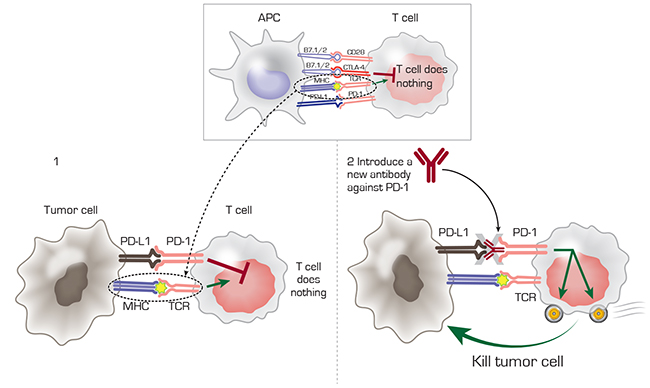Let’s get to the heart of the checkpoint blockade immunotherapy story and try to clarify some points that I left ambiguous in the previous post.
For review, we had depicted what happens when Antigen Presenting Cells that have encountered foreign bodies in its surveillance, “present” foreign material to the T cell (see top row image). The T cell can tell that what it is being presented is NOT “self;” this step was called “priming.” At the same time the T cell is recognizing what the APC is presenting it, it DOESN’T know that the APC itself is one of the good guys. In theory then, the T cell would turn around and attack the APC.
But it doesn’t attack, because the APC also binds another receptor on the T cell called the CTLA-4 (Cytotoxic T Lymphocyte Associated Protein–4). This binding event serves to turn on the T cell’s internal brakes, thereby stopping it from attacking the APC.
Now, let’s turn to the second row images. If the T cell encounters a tumor cell, it binds as it did to the APC through the MHC–TCR, because the tumor cells possess the MHC like the APC has. The tumor cell also possesses a receptor, called PD-L1 in the illustration, that applies the braking system of the T cell like the CTLA-4 did for the APC. Thus, in a normal setting, the tumor escapes from being destroyed by the T cell because it too can signal the T cell to “HEAL!”
So once again, the T cell recognizes the tumor as foreign, but is shut down by the binding of its PD-1.
In checkpoint blockade therapy, an antibody (red Y-shaped object in illustration) is created to specifically bind with PD-1–PD-L1. Therefore, when the T cell encounters the tumor cell and recognizes it as foreign or non-self through the binding of its TCR, the antibody blocks the interaction between PD-1 and PD-L1. When this happens, the tumor can’t shut down the T cell’s attack mode.
So guess what it does? IT ATTACKS, and destroys the tumor!
This is the very very basic mechanism behind checkpoint blockade. There are so many more complexities that frankly are above my pay grade to explain, so, anyone who has knowledge to correct and add to this, please let me know!
For review, we had depicted what happens when Antigen Presenting Cells that have encountered foreign bodies in its surveillance, “present” foreign material to the T cell (see top row image). The T cell can tell that what it is being presented is NOT “self;” this step was called “priming.” At the same time the T cell is recognizing what the APC is presenting it, it DOESN’T know that the APC itself is one of the good guys. In theory then, the T cell would turn around and attack the APC.
But it doesn’t attack, because the APC also binds another receptor on the T cell called the CTLA-4 (Cytotoxic T Lymphocyte Associated Protein–4). This binding event serves to turn on the T cell’s internal brakes, thereby stopping it from attacking the APC.
Now, let’s turn to the second row images. If the T cell encounters a tumor cell, it binds as it did to the APC through the MHC–TCR, because the tumor cells possess the MHC like the APC has. The tumor cell also possesses a receptor, called PD-L1 in the illustration, that applies the braking system of the T cell like the CTLA-4 did for the APC. Thus, in a normal setting, the tumor escapes from being destroyed by the T cell because it too can signal the T cell to “HEAL!”
So once again, the T cell recognizes the tumor as foreign, but is shut down by the binding of its PD-1.
In checkpoint blockade therapy, an antibody (red Y-shaped object in illustration) is created to specifically bind with PD-1–PD-L1. Therefore, when the T cell encounters the tumor cell and recognizes it as foreign or non-self through the binding of its TCR, the antibody blocks the interaction between PD-1 and PD-L1. When this happens, the tumor can’t shut down the T cell’s attack mode.
So guess what it does? IT ATTACKS, and destroys the tumor!
This is the very very basic mechanism behind checkpoint blockade. There are so many more complexities that frankly are above my pay grade to explain, so, anyone who has knowledge to correct and add to this, please let me know!


 RSS Feed
RSS Feed
